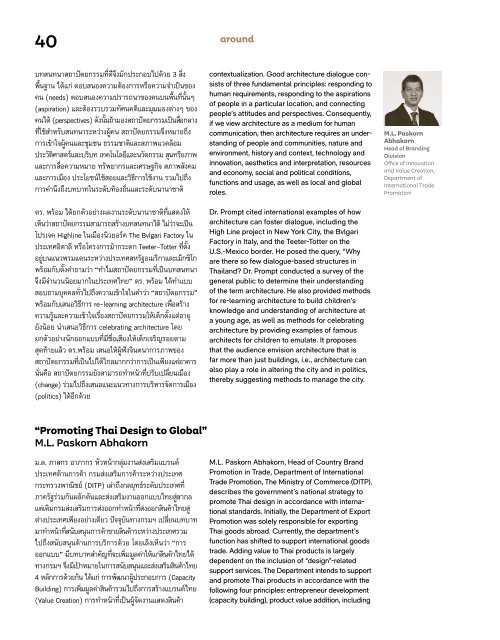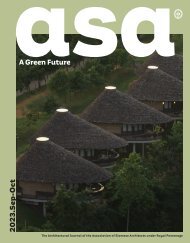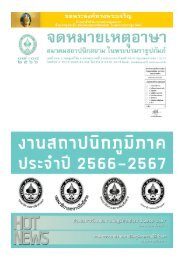ASA JOURNAL 14/2023
You also want an ePaper? Increase the reach of your titles
YUMPU automatically turns print PDFs into web optimized ePapers that Google loves.
40<br />
บทสนทนาสถาปัตยกรรมที่ดีจึงมักประกอบไปด้วย 3 สิ่ง<br />
พื้นฐาน ได้แก่ ตอบสนองความต้องการหรือความจำาเป็นของ<br />
คน (needs) ตอบสนองความปรารถนาของคนบนพื้นที่นั้นๆ<br />
(aspiration) และต้องรวบรวมทัศนคติและมุมมองต่างๆ ของ<br />
คนได้ (perspectives) ดังนั้นถ้ามองสถาปัตยกรรมเป็นสื่อกลาง<br />
ที่ใช้สำาหรับสนทนาระหว่างผู้คน สถาปัตยกรรมจึงหมายถึง<br />
การเข้าใจผู้คนและชุมชน ธรรมชาติและสภาพแวดล้อม<br />
ประวัติศาสตร์และบริบท เทคโนโลยีและนวัตกรรม สุนทรียภาพ<br />
และการสื่อความหมาย ทรัพยากรและเศรษฐกิจ สภาพสังคม<br />
และการเมือง ประโยชน์ใช้สอยและวิธีการใช้งาน รวมไปถึง<br />
การคำานึงถึงบทบาทในระดับท้องถิ่นและระดับนานาชาติ<br />
ดร. พร้อม ได้ยกตัวอย่างผลงานระดับนานาชาติที่แสดงให้<br />
เห็นว่าสถาปัตยกรรมสามารถสร้างบทสนทนาได้ ไม่ว่าจะเป็น<br />
โปรเจค Highline ในเมืองนิวยอร์ค The Bvlgari Factory ใน<br />
ประเทศอิตาลี หรือโครงการม้ากระดก Teeter-Totter ที่ตั้ง<br />
อยู่บนแนวพรมแดนระหว่างประเทศสหรัฐอเมริกาและเม็กซิโก<br />
พร้อมกับตั้งคำาถามว่า “ทำาไมสถาปัตยกรรมที่เป็นบทสนทนา<br />
จึงมีจำานวนน้อยมากในประเทศไทย” ดร. พร้อม ได้ทำาแบบ<br />
สอบถามบุคคลทั่วไปถึงความเข้าใจในคำาว่า “สถาปัตยกรรม”<br />
พร้อมกับเสนอวิธีการ re-learning architecture เพื่อสร้าง<br />
ความรู้และความเข้าใจเรื่องสถาปัตยกรรมให้เด็กตั้งแต่อายุ<br />
ยังน้อย นำาเสนอวิธีการ celebrating architecture โดย<br />
ยกตัวอย่างนักออกแบบที่มีชื่อเสียงให้เด็กเจริญรอยตาม<br />
สุดท้ายแล้ว ดร.พร้อม เสนอให้ผู้ฟังจินตนาการภาพของ<br />
สถาปัตยกรรมที่เป็นไปได้ไกลมากกว่าการเป็นเพียงแค่อาคาร<br />
นั่นคือ สถาปัตยกรรมยังสามารถทำาหน้าที่ปรับเปลี่ยนเมือง<br />
(change) ร่วมไปถึงเสนอแนะแนวทางการบริหารจัดการเมือง<br />
(politics) ได้อีกด้วย<br />
around<br />
contextualization. Good architecture dialogue consists<br />
of three fundamental principles: responding to<br />
human requirements, responding to the aspirations<br />
of people in a particular location, and connecting<br />
people’s attitudes and perspectives. Consequently,<br />
if we view architecture as a medium for human<br />
communication, then architecture requires an understanding<br />
of people and communities, nature and<br />
environment, history and context, technology and<br />
innovation, aesthetics and interpretation, resources<br />
and economy, social and political conditions,<br />
functions and usage, as well as local and global<br />
roles.<br />
Dr. Prompt cited international examples of how<br />
architecture can foster dialogue, including the<br />
High Line project in New York City, the Bvlgari<br />
Factory in Italy, and the Teeter-Totter on the<br />
U.S.-Mexico border. He posed the query, “Why<br />
are there so few dialogue-based structures in<br />
Thailand? Dr. Prompt conducted a survey of the<br />
general public to determine their understanding<br />
of the term architecture. He also provided methods<br />
for re-learning architecture to build children’s<br />
knowledge and understanding of architecture at<br />
a young age, as well as methods for celebrating<br />
architecture by providing examples of famous<br />
architects for children to emulate. It proposes<br />
that the audience envision architecture that is<br />
far more than just buildings, i.e., architecture can<br />
also play a role in altering the city and in politics,<br />
thereby suggesting methods to manage the city.<br />
M.L. Paskorn<br />
Abhakorn<br />
Head of Branding<br />
Division<br />
Office of Innovation<br />
and Value Creation,<br />
Department of<br />
International Trade<br />
Promotion<br />
“Promoting Thai Design to Global”<br />
M.L. Paskorn Abhakorn<br />
ม.ล. ภาสกร อาภากร หัวหน้ากลุ่มงานส่งเสริมแบรนด์<br />
ประเทศด้านการค้า กรมส่งเสริมการค้าระหว่างประเทศ<br />
กระทรวงพาณิชย์ (DITP) เล่าถึงกลยุทธ์ระดับประเทศที่<br />
ภาครัฐร่วมกันผลักดันและส่งเสริมงานออกแบบไทยสู่สากล<br />
แต่เดิมกรมส่งเสริมการส่งออกทำาหน้าที่ส่งออกสินค้าไทยสู่<br />
ต่างประเทศเพียงอย่างเดียว ปัจจุบันทางกรมฯ เปลี่ยนบทบาท<br />
มาทำาหน้าที่สนับสนุนการค้าขายสินค้าระหว่างประเทศรวม<br />
ไปถึงสนับสนุนด้านการบริการด้วย โดยเล็งเห็นว่า “การ<br />
ออกแบบ” มีบทบาทสำาคัญที่จะเพิ่มมูลค่าให้แก่สินค้าไทยได้<br />
ทางกรมฯ จึงมีเป้าหมายในการสนับสนุนและส่งเสริมสินค้าไทย<br />
4 หลักการด้วยกัน ได้แก่ การพัฒนาผู้ประกอบการ (Capacity<br />
Building) การเพิ่มมูลค่าสินค้ารวมไปถึงการสร้างแบรนด์ไทย<br />
(Value Creation) การทำาหน้าที่เป็นผู้จัดงานแสดงสินค้า<br />
M.L. Paskorn Abhakorn, Head of Country Brand<br />
Promotion in Trade, Department of International<br />
Trade Promotion, The Ministry of Commerce (DITP),<br />
describes the government’s national strategy to<br />
promote Thai design in accordance with international<br />
standards. Initially, the Department of Export<br />
Promotion was solely responsible for exporting<br />
Thai goods abroad. Currently, the department’s<br />
function has shifted to support international goods<br />
trade. Adding value to Thai products is largely<br />
dependent on the inclusion of “design”-related<br />
support services. The Department intends to support<br />
and promote Thai products in accordance with the<br />
following four principles: entrepreneur development<br />
(capacity building), product value addition, including


















